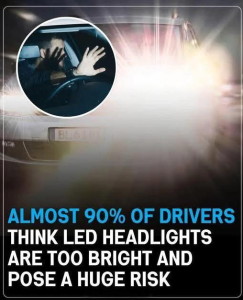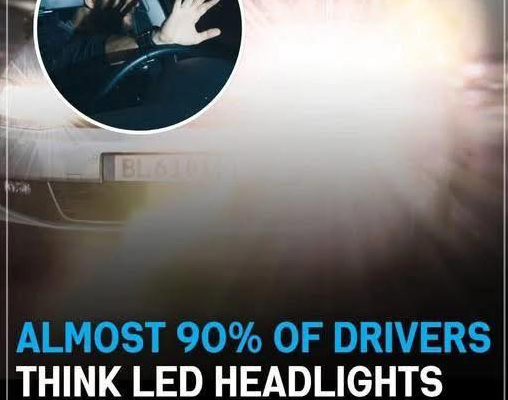
Blinded by the Light? 90% of Drivers Say LED Headlights Are Just Too Much
In recent years, the automobile industry has witnessed a revolution in lighting technology. Gone are the days when halogen bulbs ruled the road. Instead, LED (light-emitting diode) headlights have become the standard for many manufacturers, promising better visibility, longer lifespan, and a modern aesthetic. But while automakers tout these benefits, a growing number of drivers have voiced serious concerns. In fact, surveys suggest that nearly 90% of drivers feel LED headlights are excessively bright and often blinding, creating more danger than safety on the road.
This raises a critical question: Have we gone too far in the quest for brighter, whiter light?
The Rise of LED Headlights
LEDs have been praised for their energy efficiency and durability. Unlike traditional halogen bulbs, which have a yellowish tint and relatively short lifespan, LEDs can last tens of thousands of hours while producing a clean, white light that closely mimics daylight.
Automakers seized on this technology, not only for practical benefits but also for design flexibility. Thin, sharp LED strips became signature elements in brand styling, from Audi’s iconic daytime running lights to the aggressive beams seen on luxury SUVs. Consumers loved the futuristic look, and regulators supported the transition because LEDs consume less energy and often meet technical standards for brightness and alignment.
But what looks sleek on paper doesn’t always feel comfortable on the road.
The Problem: Too Bright, Too Blinding
For many drivers, encountering an oncoming car equipped with ultra-bright LEDs feels less like a safety feature and more like a direct assault on the eyes. Motorists describe being “dazzled,” “flashed,” or “temporarily blinded” when a vehicle with modern headlights approaches at night.
Some drivers even report afterimages or difficulty adjusting their vision after passing an LED-equipped car. For older drivers, whose eyes naturally adjust more slowly to changing light conditions, the experience can be especially disorienting and dangerous.
A 2024 study by road safety organizations found that 90% of surveyed drivers believed LED headlights were unnecessarily intense. More than half admitted they occasionally had to slow down or avert their gaze when facing oncoming cars. This indicates a troubling paradox: the very technology designed to improve nighttime visibility might actually be reducing it for everyone else on the road.
Why LEDs Feel Harsher
Several factors explain why LED headlights feel more glaring than older halogens, even if their measured brightness technically complies with regulations.
-
Color Temperature
-
Halogen bulbs emit a warm, yellowish light (around 3,000 Kelvin), which is softer on the eyes.
-
LEDs, by contrast, often range from 5,000–6,500 Kelvin, producing a blue-white tone that mimics daylight but also causes more glare. The human eye perceives blue-rich light as brighter, which exaggerates the discomfort.
-
-
Beam Pattern and Intensity
-
Poorly aligned headlights scatter light above the horizon line, sending glare directly into the eyes of oncoming drivers.
-
Many aftermarket LED kits, especially when retrofitted into halogen housings, create uneven beam patterns, worsening the problem.
-
-
SUV and Truck Popularity
-
Larger vehicles sit higher, meaning their headlights shine directly into the mirrors or eyes of smaller car drivers. With LEDs being common in SUVs, glare is magnified.
-
-
Aging Eyes
-
Drivers over 50 are especially vulnerable because their pupils shrink and their lenses scatter more light, making glare more pronounced. As the population ages, this issue is becoming more widespread.
-
Real-World Consequences
Glare from LED headlights isn’t just an annoyance—it can have real safety implications.
-
Slowed Reaction Times: Studies show that temporary “dazzle blindness” can last several seconds. At highway speeds, that’s enough time to miss a hazard.
-
Lane Departure: Drivers sometimes drift unintentionally as they look away from bright lights or squint to avoid glare.
-
Increased Anxiety: Many motorists report feeling tense or even avoiding nighttime driving altogether because of headlight glare.
Some organizations have suggested that headlight glare could be contributing to nighttime accident rates, though definitive data remains complex because of multiple influencing factors. Still, anecdotal reports are so widespread that regulators are taking notice.
What Are Regulators Doing?
In the United States, the National Highway Traffic Safety Administration (NHTSA) has faced growing pressure to address the headlight issue. For decades, regulations primarily measured brightness and beam spread in controlled conditions—but real-world effects, like glare intensity, were not adequately factored in.
In 2022, NHTSA approved adaptive driving beam (ADB) headlights, already common in Europe and Japan. These systems use sensors to automatically adjust light distribution, dimming sections of the beam when they detect oncoming cars while keeping other areas brightly lit. This technology could strike a balance between safety and comfort.
However, widespread adoption in the U.S. has been slow, and many vehicles still rely on fixed LED beams that don’t adapt. Furthermore, retrofitted LEDs in older vehicles often bypass regulations altogether, leading to uncontrolled glare.
The Drivers’ Perspective
Drivers’ frustration has spilled onto online forums, social media, and advocacy groups. Comments like “I feel like I’m being interrogated on the highway” or “Every night drive is a battle against headlights” are common.
Some even argue that car manufacturers prioritize style over safety, chasing the sharpest, whitest look to make vehicles stand out in showrooms, without fully considering how it affects others on the road.
Petitions calling for stricter headlight standards have garnered tens of thousands of signatures. In the UK, one petition to Parliament described LED glare as “a blight on night driving” and demanded government intervention.
Possible Solutions
While the debate continues, several measures could help reduce LED glare without eliminating the technology entirely:
-
Adaptive Beam Technology – Encouraging manufacturers to integrate ADB systems as standard could dramatically improve balance between visibility and comfort.
-
Stricter Regulation – Governments may need to update testing protocols to consider real-world glare and color temperature, not just lab measurements.
-
Better Alignment Enforcement – Many cases of glare stem from poorly aimed headlights. Routine inspections could help ensure beams are properly directed.
-
Consumer Awareness – Drivers installing aftermarket LED kits should be educated about compatibility and beam pattern risks.
-
Design Adjustments – Automakers could prioritize slightly warmer color temperatures or diffused patterns that improve safety without sacrificing style.
A Shared Road Requires Shared Responsibility
Ultimately, headlights are supposed to illuminate the road, not blind fellow drivers. The overwhelming feedback—90% of drivers saying LEDs are “too much”—suggests that the balance has tipped in the wrong direction.
Technology should enhance safety for everyone, not just the person behind the wheel of the car with the brightest lights. As regulators, automakers, and consumers debate the future of vehicle lighting, one truth remains clear: if drivers feel unsafe because of glare, then the system is failing.
LED headlights may represent progress, but progress without consideration can backfire. The challenge now is to harness the benefits of LEDs while ensuring they don’t leave the rest of us squinting, stressed, and—ironically—less safe on the very roads they’re meant to illuminate.

